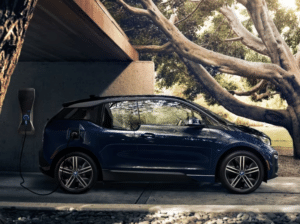Introduction – Range-Extended Electric Vehicles
In the greener pastures of the future, vehicles whisper down highways with minimal impact on our planet – a vision that brings us to the innovative doorstep of range-extended electric vehicles (REEVs). These vehicles combine the eco-conscious ethos of electric driving with a pragmatic solution to range anxiety, courtesy of an auxiliary gasoline engine.
This deep dive into REEVs will unfold their unique niche, offer a closer look at standout models like the BMW i3 REx, and discuss the broader environmental implications and incentives shaping their adoption.

The Unique Appeal of Range-Extended Electric Vehicles
REEVs stand at a crossroads, blending the sustainability of electric vehicles (EVs) with the long-distance reassurance provided by Plug-in Hybrid Electric Vehicles (PHEVs). The signature feature of a REEV is its ability to operate primarily on electric power, with a gasoline engine kicking in to generate electricity once the battery depletes. This design strategically addresses one of the most significant barriers to EV adoption: range anxiety.
The petrol engine does NOT drive the car directly. Instead, the petrol engine acts as a generator to recharge the battery, extending the vehicle’s range when the battery gets low. This setup ensures that for most daily uses, the vehicle operates solely on electric power, hence offering zero tailpipe emissions during those periods. The petrol engine is essentially a backup to extend the vehicle’s driving range when necessary, not the primary source of propulsion.
On the other hand, Plug-in Hybrid Electric Vehicles (PHEVs), like the Toyota Prius Prime, are designed with both an electric motor and a conventional petrol engine. In PHEVs, the petrol engine plays a more active role in driving the vehicle, especially when the battery’s electric charge is depleted.
Unlike REEVs, in many PHEVs, the petrol engine can directly drive the vehicle’s wheels, in addition to or instead of the electric motor. PHEVs can be recharged from an outlet to utilize their electric-only range before switching to hybrid mode, which uses both fuel and electric power.
In the Spotlight: The BMW i3 REx
BMW i3 REx Review
The BMW i3 REx is a testament to BMW’s commitment to innovation and sustainability. With its visionary design and reliance on renewable materials, the i3 REx is as much a statement piece as it is an automobile. The vehicle shines in urban settings, offering brisk acceleration and a tight turning radius ideal for city driving.

Beyond its performance, the i3 REx astounds with a cabin that feels both futuristic and eco-friendly. Drivers are greeted by a spacious interior, largely due to the car’s carbon fiber-reinforced plastic frame that allows for less bulk and more room. The iDrive infotainment system remains a benchmark for vehicular tech, providing intuitive access to navigation, entertainment, and vehicle settings.
Performance-wise, the BMW i3 REx’s electric motor delivers a robust experience, but it’s the range extender that merits a closer examination. The 650cc two-cylinder engine is not designed to propel the car directly; rather, it serves as a generator, extending the vehicle’s range and alleviating the common EV concern over finding a charging port on longer trips.
In electric mode, efficiency is king, but when the petrol engine hums to life, fuel consumption is higher than in conventional hybrids. This makes the i3 REx a paragon for mostly urban with occasional long-distance drivers, keen on minimizing their environmental footprint without getting tethered too closely to the grid.
The Wider Environmental Perspective
REEVs like the BMW i3 REx invite a nuanced discussion regarding their environmental impact. On one hand, these vehicles significantly reduce emissions by prioritizing electric power, which is especially compelling when the electricity is sourced from renewable energy. On the other hand, manufacturing complexities, particularly around battery production, introduce considerations about the total lifecycle emissions of REEVs.
Compared to traditional gasoline vehicles, REEVs offer a substantial reduction in operational emissions. However, when compared to fully electric vehicles, the picture becomes slightly more complex, factoring in the gasoline engine’s presence. Prospective buyers are encouraged to consider their typical driving patterns and the electricity sources in their region when evaluating a REEV’s environmental suitability.
Navigating Incentives and Infrastructure
Adopting a REEV comes with potential economic perks, thanks to various government incentives aimed at encouraging low-emission vehicles. In the United States, for instance, buyers can benefit from federal tax credits, which, although variable, can substantially lower the upfront cost of a REEV. These incentives are region-specific, underscoring the importance of local research for prospective buyers.
Charging infrastructure remains a pivotal factor in the REEV equation. Urban dwellers may find a wealth of charging options, but those in suburban or rural areas might face challenges. Fortunately, the auxiliary gasoline engine in REEVs provides a cushion against insufficient charging options, making them a more flexible option for many drivers.
Entering the Future with REEVs
The trajectory for REEV technology is promising, with continuous advancements in battery efficiency and renewable energy integration heralding a more sustainable future. As these vehicles evolve, the expectation is for an even greater emphasis on electric propulsion, potentially relegating the gasoline engine to a mere backup role.
Conclusion – Range-Extended Electric Vehicles
Range-extended electric vehicles represent a strategic compromise in the transition towards a fully electric future. They are particularly adept at serving the needs of drivers who are eager for the benefits of electric driving but require the security blanket of a gasoline engine for longer journeys.
With models like the BMW i3 REx offering a glimpse into the potential of REEVs, it’s clear that these vehicles are more than just a stopgap; they’re a meaningful step toward sustainable mobility. As technology marches forward and the world pivots more decisively toward renewable energy, REEVs stand poised to play a significant role in our collective journey to a cleaner, greener planet.
